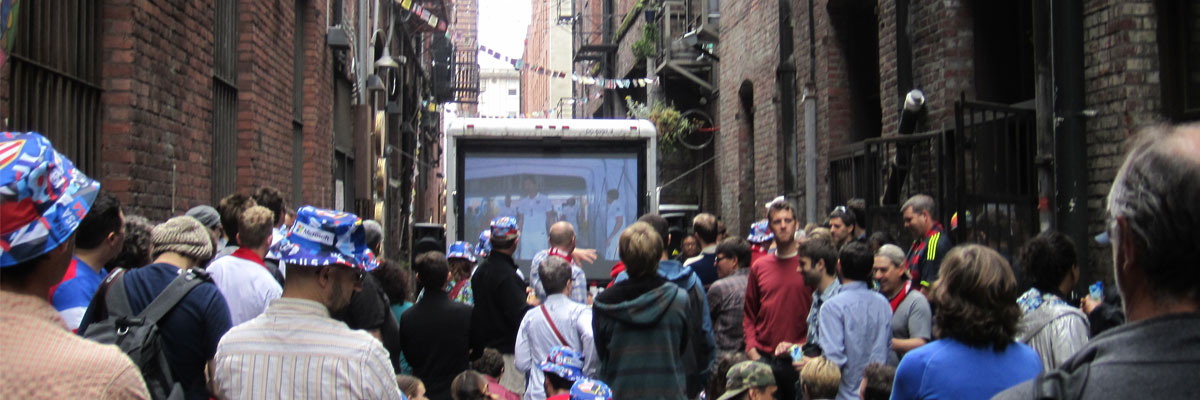BACKGROUND
The Seattle Department of Transportation (SDOT) initiated the Festival Street program as a way to generate momentum towards implementation of the city’s Pedestrian Master Plan. SDOT proposed the Festival Street program to the Seattle City Council in 2011. Based on the precedents of Seattle’s 2007 Complete Streets policy and 2009 Pedestrian Master Plan, the Council formally authorized the Festival Street program in the Seattle Municipal Code.
The Ordinance defines a festival street as a public place that has been designated for recurring temporary closure to vehicular traffic for the purpose of pedestrian-oriented special activities. Eligible public spaces include streets, avenues, ways, boulevards, drives, places, alleys, sidewalks, planting strips, squares, triangles and rights-of-way. Activities may include music or dance performances, art shows, games or other pedestrian-oriented events and celebrations. The Festival Street program encourages community-driven activation of streets. Designation proposals may be sponsored by community groups, individuals, private developers, government agencies, or any other organized local interest. Once a proposal is initiated, it must first be approved by the applicable Neighborhood District Council. Once the sponsor obtains this approval, the proposal may be sent to the SDOT Director for final authorization.
Since the program began, the SDOT director has authorized four festival streets: S. Roberto Maestas Festival Street, Nord Alley, Canton Alley, and the Georgetown Festival Street. The Georgetown Festival Street includes a capital upgrade that will result in a raised section of roadway that is level to the sidewalk. The finished street will function like a “woonerf” or “shared space” - the road will remain open to vehicular traffic, but the new design will discourage cut-through traffic, slow vehicles down, and provide new parking amenities. The finished project will also feature infrastructure to support events and programming, including new bike racks and an outdoor power source.
REVENUE AND FINANCING
The funding sources for Seattle’s Festival Streets vary. Seattle’s first three Festival Streets did not incorporate significant capital improvements, and therefore did not require significant fundraising efforts. For example, the sponsor for the Nord Alley Festival Street began implementing low-cost events as soon as the designation was granted, including closing the street for a neighborhood World Cup viewing party. Simple, pedestrian-focused events such as this do not require major financial resources, and are easily implemented by community groups or individuals. Revenue-generating events on festival streets are not explicitly prohibited, but they are also not encouraged. The intent of the Festival Street Program is to lower barriers for community groups trying to organize free events for their neighbors and friends.
Seattle’s newest project in the program, the Georgetown Festival Street, responds to a community vision that requires a significant capital improvement. Neighborhood project sponsors worked to secure a $1,130,000 grant to fund construction. This grant was administered through Seattle’s Neighborhood Street Fund program, which pays for neighborhood transportation projects that are identified and prioritized by a community. The Neighborhood Street Fund program is in part funded by the 9-year “Bridging the Gap” levy that Seattle voters passed in 2006. In addition to addressing a backlog of citywide transportation maintenance projects, this levy was specifically intended to fund complete streets projects and support proposals made through the Neighborhood Street Fund program.
ACTIVATION AND PROGRAMMING
Activation and programming are at the center of the Festival Street Program. Once SDOT has approved a Festival Street designation, the Director will issue a one-year Festival Street permit - a special Street Use permit intended to allow community groups, businesses, or individuals to plan one or more closures of the festival street on a pre-approved schedule and for pre-approved activities throughout the year. The Festival Street permit does not cover large events, such as those that meet Seattle’s existing Special Event permit thresholds.
By requiring only one application and fee payment per year, the Festival Street permit structure encourages neighborhoods to make frequent use of these new public places for small-scale community events.
The Festival Street permitting process requires the sponsoring entity to outline a calendar of proposed events throughout a given year, but it includes a framework for amending this calendar if permitees wish to request additional event approvals after their permit is approved. The Street Use Festival Street permit also requires applicants to provide traffic control and signage plans as well as insurance documentation. These permitting requirements are similar to those outlined in San Francisco’s existing Pavement to Parks proposal process.
Primary Model Type
Event-based
Overlapping Models
Grassroots Partnerships
Public-Private Partnerships
Location
Seattle, WA
Sponsor
Seattle Department of Transportation (SDOT)
Space Type
Street or Alley
Use Level
Varies
Budget Range
Cost to set-up: $
Manager resource level: Varies
Needs Addressed
- Reduces barriers to creating small community events in public space.
- Makes fast progress towards city-wide pedestrian safety and livability goals
- Maintains agency responsibilities within available resources

